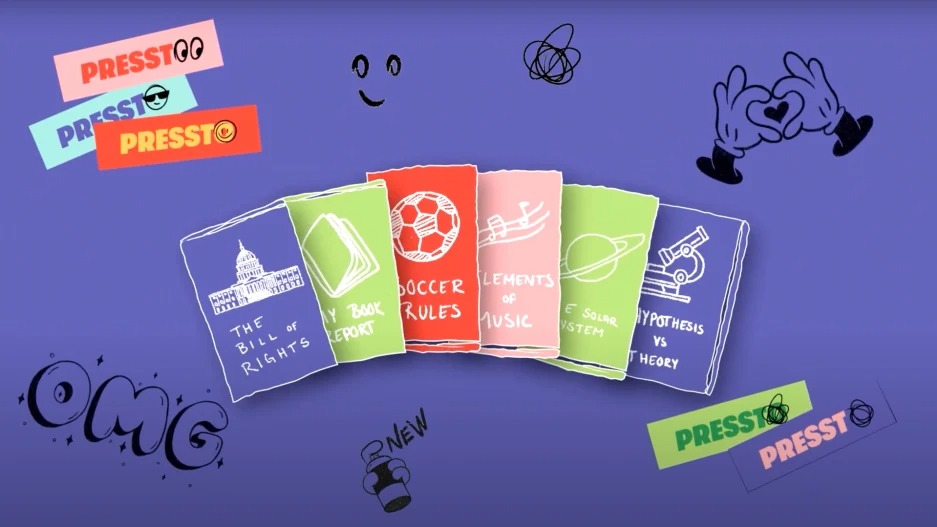- | 8:00 am
This generative AI tool actually teaches kids how to write
With the help of a renown tech matriarch and a growing cohort of public school teachers, Pressto offers a new outline for writing education.

Esther Wojcicki isn’t scared of ChatGPT. As a former teacher and the founder of one of the largest high school journalism programs in the country, she knows a thing or two about teaching the art of the written word, and instead of worrying that AI is going to turn students into cheaters, she thinks it can turn them into engaged writers.
Wojcicki spent nearly 40 years teaching journalism and English at Palo Alto High School (aka Paly), in Palo Alto, California. She also raised three daughters who went on to become not just highly literate but so inspirational for their STEM work that they have their own Barbie dolls: Susan (YouTube’s longtime CEO, who recently stepped down), Anne (the founder and CEO of 23andMe), and Janet (a professor of pediatrics at University of California, San Francisco). Throughout her career, and especially since retiring from Paly in 2020, Wojcicki has tried to pass on her teaching skills to others through books, speaking tours, and consulting, but she knows these methods don’t often scale. That’s why last month she became the chief academic advisor at Pressto, an ed tech startup putting generative AI in the hands of elementary school teachers in order to help them teach kids how to write.
Pressto uses generative AI to create writing prompts and help teachers with lesson plans, but it’s the tool’s ability to simplify collaboration that most mirror’s the Wojcicki’s method. “At the heart of Pressto,” she says, is the belief that you can’t teach writing “in isolation. Kids have to be connected to other kids.”
Daniel Stedman, a former journalist and founder of Brooklyn Magazine, started Pressto in 2021, well before ChatGPT wowed the world with its ability to write about complex topics based on minimal prompts. He was simply frustrated about how writing was being taught (or not being taught) in schools. He tried to volunteer in a high school journalism class in Brooklyn, near his home, but he found that few were still being offered.
When Stedman looked into what writing instruction was like in elementary schools, what he found was bleak. “The system is doing a really terrible job,” he says. “It might sound obvious, “but kids need to be able to write well to apply for college, or a job, or to communicate with their friends or to communicate in general, and I think that there is obviously a pretty broad communication breakdown.”
From a student perspective, Pressto eliminates that stomach-lurching feeling of staring at a blank screen by offering clickable text blocks that prompt students to structure their ideas (in a much more interactive way than the dreaded outline). Teachers can choose to assign journalistic exercises, like op-eds and news articles, or traditional essays—and then help students turn their writing into a zine that’s shareable virtually and physically.
Stedman and his team know that when students choose what they write about, they’re more engaged. But kids aren’t particularly good at coming up with writing topics on their own, and teachers can struggle to help them. Pressto’s AI offers topic generators based on specific personalized prompts that appeal to kids.
Are third graders really into Pokémon and also reading Charlotte’s Web? Pressto can generate topics for a “compare and contrast” essay about Wilbur and Pikachu (or a dozen other Pokémon that most teachers or parents have never heard of), much to their delight. The platform also includes unique classroom features that make it easy for students to create their own paper magazine to share their stories.
Since Pressto’s January 23 launch, more than 1,300 teachers from nearly 700 schools across the U.S. (and four other countries) are now using the platform, which Presto is offering on a no-fee basis though the end of the year. After that, Pressto plans to charge $4 per student annually, and the company has begun working directly with several large school districts to arrange contracts for 2024.
Todd Henry, a special education teacher at Northwest Elementary in Lincoln, IL, says he’s noticed that typically writing-averse, below-grade-level students respond differently when they’re allowed to write about what they want “in a medium that is ‘cool.’”
Henry also uses Pressto’s AI to accommodate different learning levels and instill confidence in his students, who are often afraid of writing, “especially older elementary”—5th grade—”boys, who are usually quite reluctant to put feelings, opinions, and thoughts to paper.” He realizes that he is more accepting of new technology in the classroom than many of his fellow teachers, but he says he’s still “concerned about AI,” particularly when it comes to “deflating students’ confidence” when they compare their work to AI-generated compositions.
Stedman understands the fears, but he also says writing education is due for some disruption. Wojcicki certainly isn’t afraid. She’s helped mold generations of competent writers despite spellcheck, Wikipedia, and grammar checkers, not to mention basic computers. After glimpsing a Macintosh in the window of a local store in Los Altos, California in 1987, Wojcicki says she went against the advice of her local school district and applied for a grant. She ended up with six Macs in her Paly classroom that she and her students eventually learned how to network and use to create multiple publications. That’s when people around Palo Alto started to pay attention to her journalism program, (including Steve Jobs, when she started teaching his daughter). Onlookers went from remarking, “‘What the heck is she doing in that room?’” Wojcicki recalls, to “‘This program is kind of special.’”






































